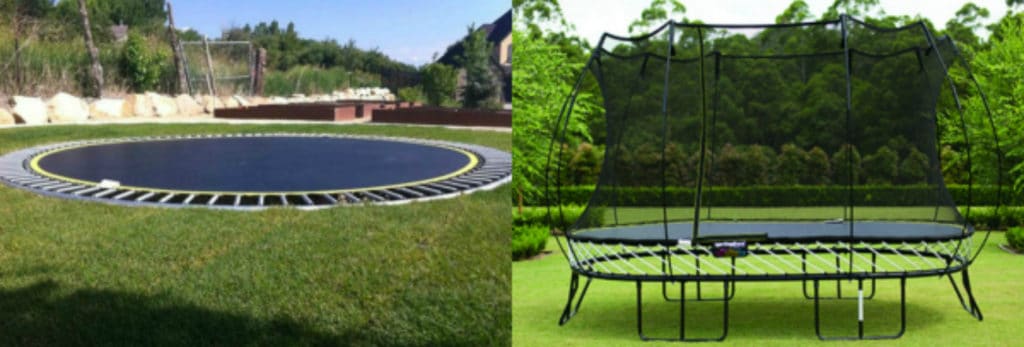When I was twenty-two years old, I wanted two things: 1. To be understood. 2. For people to think I was good at my job....Read more
Inground and above-ground trampolines are different in terms of their format and design. Safety features and bounce experience are also different. People of all ages can get moving and have fun together on trampolines. It is a terrific benefit of owning one. Isn’t it? You have the choice between an in-ground trampoline and an above-ground trampoline.

Both types of trampolines have their advantages and disadvantages. Both provide incredible jumping experiences. Choose the trampoline that is most suited to the requirements and preferences of your family. In this article, we will compare and contrast the two distinct types of trampolines. Now you may choose the model that is most suitable for your garden. Good luck!
Related Article: Can You Wear Shoes On The Trampoline
What is an in-ground trampoline?
In-ground trampoline is fitted below ground and has a jumping area that is either level with or slightly elevated from the ground. In-ground trampolines are actually planted directly into the ground to make sure that they appear consistent and natural. These trampolines blend in nicely with the environment. We all love it!
The construction
The construction of the trampoline is hidden behind a hole dug into the ground. This makes both the jumping surface and the trampoline easier to access. It makes them less conspicuous. In-ground trampolines are risk-free. They have long-lasting structures that provide users with a great jumping experience. Nobody wants to leave that alone!
The popularity
Their popularity is skyrocketing because of their aesthetic appeal and how they boost security. In-ground trampoline experience is both entertaining and safe. It is vital to have the installation done correctly. Take care of Adequate drainage and follow all safety regulations. My dear! Safety is in your hands.
Age limit
Jumping on a trampoline can be great exercise for kids. Trampoline use can also be dangerous and lead to injuries. It’s important to pay attention to the safety guidelines. Your youngster needs to be six years old or older before they may safely use a trampoline.
Trampolines have the potential to be both safe and fun if they are used properly. Think about your child’s safety, the trampoline’s quality, and the seller’s reputation while making your purchase.
Are in-ground or above-ground trampolines safer?
In-ground or above-ground trampolines are both safe If they are used appropriately. Both in-ground and above-ground trampolines are capable of providing a safe and secure environment for jumping. In terms of safety, let’s find out which one has the upper hand. There are a number of significant distinctions between the two types.
Possibility of falling from a great height
In-ground trampolines have a dense appearance because the jumping mats are positioned at a lower height relative to the ground. The possibility of falling from a great height and the danger of sustaining major injuries may be reduced.
Inground trampoline: Accessibility.
In-ground trampolines are more accessible because you don’t have to use a ladder or steps. You can simply step directly onto the jumping surface. No hustle, just jumping and jumping all day!
Tidier and more beautiful appearance :
In-ground trampolines have a far easier time blending in with the surrounding plants. It results in a tidier appearance in the backyard.
Above-ground trampolines are movable.
They are often more movable, and above-ground trampolines provide you with more choices in terms of the design of your yard and maintenance. You wanna change the place? Okay, just do it!
The majority of trampolines that are elevated off of the ground come with nets. It has enclosures to protect users. Forget falling off or incurring injury!
Above-ground trampolines can be made just as safe as in-ground trampolines by following the appropriate safety procedures. Equip them with the necessary safety gear. In-ground trampolines may be safer due to their lower height and greater ease. Safety enclosures and age-appropriate use can make the users of trampolines have fun and risk-free time when using trampolines.
What benefits of the inground trampoline?
The benefits of an in-ground trampoline include aesthetic appeal and safety for some users. When the jumping surface is lower to the ground, there is less of a chance that someone may fall. It is an excellent choice for younger children as well as adults who have difficulties with movement.
In-ground trampolines are versatile enough to accommodate a wide variety of garden layouts. The homeowner has the option of adding plants and other decorations to the area surrounding the trampoline. It can personalize and improve the quality of the space. Time to get an inground trampoline now!
Special children are gems, and they have a right to enjoy. Children and people who have special needs like restricted mobility benefit from in-ground trampolines. In-ground trampolines are flush with the ground; there is no need to climb a ladder. This eliminates the barrier that was previously there. As a direct consequence of this, there is no place to fall from.
When it comes to physiotherapy, in-ground or sunken trampolines are among the finest. For those with poor muscular tone, it helps to increase their core strength. Inground trampolines simulate the feeling of jumping on a real trampoline. Users of inground trampolines are able to keep their equilibrium. Enhancing a person’s coordination can help with their learning as well as their neurodevelopment.
Disadvantages of the inground trampoline?
The method of installation is more difficult and time-consuming than an above-ground trampoline.
In order to create a safe and solid jumping surface, the hole needs to be dug very carefully. It is possible that the total price could increase if you want assistance in setting up.
The efficiency of the drainage system
An inground trampoline is sunk into the ground; a trampoline may be susceptible to problems with standing water. Installing drainage systems is necessary to prevent water from pooling up. It could result in costly repairs and an unhealthy environment for jumping.
difficult to relocate
In-ground trampolines are less movable and less stable than their counterparts. Due to the fact that they are anchored to the ground, they are difficult to relocate once they have been set up.
Potential problems with inground trampolines
- Creating the pit
- leveling the area around the hole
- hiring a mini-digger to dig the hole
- soil disposal
- Keeping wildlife out of the hole
- Weeds growing out of the hole
- children are climbing into the hole.
Can you put an above-ground trampoline in the ground?
Yes, It is possible to put an above-ground trampoline in the ground. Doing so involves planning and preparation. It needs attention to safety concerns. Trampoline manufacturers typically have a variety of conversion kits that may be purchased separately and make the procedure more controllable.
To begin, you will need to select a location in the backyard
The area needs to be cleaned so that it can support the structure of the trampoline.
After the hole in the trampoline has been shaped appropriately, the frame may be inserted into it.
The size of the hole will be determined according to the model of the trampoline as well as the instructions provided by the manufacturer.
Insert the frame of the trampoline in the hole. If the jumping surface is parallel to the floor, it will be possible to ensure that the bounce will be both safe and uniform.
What are the disadvantages of above ground trampoline?
Above-ground trampolines are not the ideal option for homeowners who want their trampoline to blend in with the rest of the property. It is because of the elevated position that these trampolines occupy on the land.
Users of trampolines that are placed above ground may be at a greater risk of harm from falls from greater heights. They can unintentionally leap off the trampoline or tumble off it. This is because the height at which they are falling is greater. It is possible for safety cages to raise the price of the trampoline.
Trampolines that are placed above the ground are more susceptible to being moved by the wind. Installing the device in a safe location and securing it with strong anchors will help alleviate this problem to some degree.
If your children have been begging you to buy them a trampoline for the holidays, you may be trying to decide between an above-ground and an in-ground one. There are a few reasons why we think kids prefer in-ground trampolines. Remember that the ages of your children may necessitate adjustments to this list.
What benefits of the above-ground trampoline?
The ability of an above-ground trampoline to adapt to variations in the slope is one benefit. On sloppy kinds of surfaces, installing an above-ground trampoline, which provides a jumping area that is both safe and level, can be done more rapidly. Unusually shaped yards can benefit from owning above-ground trampolines because of the versatility of these trampolines.
When it comes to the yard’s landscaping, the majority of the time, it is preferable to install an above-ground trampoline. Once assembled, trampolines placed above the ground do not present much of a risk to the local wildlife. Above ground, the trampoline doesn’t do many alterations to your yard.
Trampolines that are not built into the ground are easier to use and more cost-effective than trampolines that are built into the ground.
It requires less time and fewer components, which results in cost savings in the long term.
An above-ground type provides you additional options in the event that your plans need to be adjusted and you need to sell or relocate your trampoline. Because they are not attached to the ground in any way, they are much simpler to disassemble and relocate. This perk is especially helpful for families who may relocate at some point in the future or who just want to vary their gardening every so often.
The presence of numerous built-in safety elements in above-ground trampolines. Some models are even more child-friendly than others since they come with padding or safety nets. These preventative measures were designed with the goal of preventing mishaps such as falls. Above ground, a trampoline can provide parents with the peace of mind that their children will be protected while they are jumping on the trampoline.
Above ground trampoline makes everyone participate in the activity. The elevated area is perfect for group activities such as family games, friendly matches, or workouts with a large number of people. The trampoline serves as the focal point of unforgettable get-togethers. Because it allows everyone to participate, this type of interactive play is perfect for gatherings of all kinds, including parties, play dates, and family get-togethers.
Which is an expensive inground or above-ground trampoline?
The above-ground trampoline by itself is available at a very reasonable price. There are no additional costs for its assembly or installation. Above-ground trampolines are typically sold at a lower price point in comparison to their underground counterparts.
The in-ground trampoline kit by itself will set you back more than a thousand dollars. Most of your spending will go toward having the equipment installed by a trained professional. With no previous expertise with installations, it is highly recommended that you have specialists take care of it for you.
When comparing the costs of an inground and an above-ground trampoline, above-ground is clearly the better deal.
Landscaping and pipe installation are some of the optional extras that might increase the effort needed to set up an in-ground trampoline. A less permanent option, above-ground trampolines can be purchased for $300–$500 on Amazon.
The best gear can cost more than $1,000, and a decent in-ground trampoline can be bought for as little as $500. If you have a difficult site or hard terrain that is difficult to deal with, excavation costs, which normally range from $400 to $1,000, may need to be added to this rate.
When you factor in excavation, installation, and materials, the total cost of an inground trampoline might be anywhere from $2,000 to $4,000.
Conclusion
Know the difference between in-ground trampolines and above-ground trampolines before making a purchase decision. There are advantageous and disadvantageous features associated with each type. Because of its integrated design and lower profile, in-ground trampolines provide more creative landscaping alternatives than above-ground trampolines.
Above-ground trampolines are simpler to build. They can be adjusted to accommodate uneven ground. They may offer improved airflow while the user is jumping. There are considerable benefits associated with both forms. It is necessary to take the appropriate precautions, to be properly supervised, and to do routine maintenance on your trampoline.
Trampoline can give you the most memorable and thrilling family fun if you take these considerations into consideration.

When I was twenty-two years old, I wanted two things: 1. To be understood. 2. For people to think I was good at my job. As a first time founder, I remember feeling under-qualified. I felt like an impostor—and it showed. I struggled to communicate my value in a way that my colleagues and potential investors could understand. I realized I needed to clarify my message and use social media as a tool to help me build my personal brand. This would help me look more credible, I thought. So I got to work. I updated my social media profiles, built a personal website, and began sharing my story online. The more content I shared, the more confident I became. And the more confident I became, the more credible I appeared. Now i am writing blogs for madeforkids.co.uk on different topics on kids.
- Latest Posts by Anna Vatuone
-
What Are The Uses Of A Drone
- -
What Are The Uses Of Playhouse
- -
How To Get A Child To Warm Up To You
- All Posts
